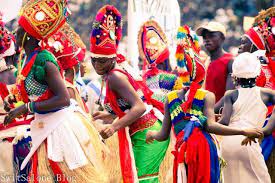This article discusses the cultural heritage of Sierra Leone from the culture, down to the cultural institutions, historical and heritage sites.
CULTURE OF SIERRA LEONE
The most outstanding feature of the country’s cultural life is its dancing. The internationally known Sierra Leone National Dance Troupe first won widespread acclaim at the 1964–65 New York World’s Fair and continues to perform in the 21st century. The different communities of the country have their own styles of costume and dance. In addition, certain closed societies, such as the Wunde, the Sande (Bundu), and the Gola, have characteristic ceremonial dances. A wide range of agility, gracefulness, and rhythm is displayed; in addition, there are elements of symbolism in most of the dances. Drums, wooden xylophones (called balaphones), and various stringed instruments provide the musical background.
Read: PROVINCES OF SIERRA LEONE
The carving of various wooden masks in human and animal figures for the dances is especially advanced in the southern region. The Sande mask worn on the head of the chief dancer during the ceremony that welcomes the reappearance of female initiates from their period of seclusion is perhaps the best-known carved figure in Sierra Leonean art. It is a black symmetrically stylized head of an African woman with an elaborately plaited pyramidal coiffure adorned with various figures and with a facial expression of grave dignity and beauty. The iconography is of great significance and meaning.
The weaving of cloth, typically blue, brown, white, or a combination of these colors, is carried out in the southern and eastern regions by the Mende and the Kono. Thread spun from the cotton bush Gossypium is used in weaving. This handwoven cloth is an important item of barter and wealth and is used in many ceremonies and rituals. The cloth is made into coats for men or is worn as a wraparound lower-body garment by women and is also used as a bedspread. In the north, among the Temne, imported cotton or satin is tie-dyed in beautiful patterns with indigo, the red juice of the kola nut, or imported dyes. In the west, baskets are made with dyed raffia, and patterned slippers are fashioned from dyed wool.
CULTURAL INSTITUTIONS
The Sierra Leone National Museum in Freetown contains historical, ethnographic, and archaeological collections. Other museums include the Sierra Leone National Railway Museum, also in Freetown. Bunce Island, a national historic site, was once home to a British slave castle that operated from the 1670s until 1808; tours of the island are conducted among the ruins of the old dormitories, factory house, prison, and watchtowers. Fourah Bay College and Njala University College both have libraries; the former houses the public archives.
HISTORICAL & HERITAGE SITES
To date, 18 historical sites have been proclaimed as ‘National Monuments’ under Sierra Leone’s 1946 Monuments and Relics Ordinance. The majority of these proclamations were made during the colonial era. Two sites in Freetown, a fireplace removed from a now demolished building in Charlotte Street and the old military butts at the junction of King Harman Road and Hill Cot Road, are no longer traceable. Information about the remaining sites can be found here. There are many more important historical and archaeological sites to be found throughout Sierra Leone. Every town and village has its history and its heritage sites.
National Railway Museum
The Sierra Leone National Railway Museum was opened in 2005 in the old railway workshops in Cline Town area of Freetown.
The Marron’s Church
This is one of the oldest places of worship in the City dating from 1820 when the founder received a Crown Grant of the land between Percival and Liverpool Streets with frontage in Westmoreland Street.
Heddle’s Farm
This was the site of a house, which commanded a fine view over Freetown. It is found on the old Leicester Road and dates from 1820. This was a prominent residence, which is now in ruins.
De Ruyter Stone at King Jimmy
This is Freetown’s oldest monument. It lies buried 6 feet underground, just above the high watermark at the King Jimmy Market, near the Connaught Hospital. Mentioned by early travelers in ships journals.
Bunce Island Fortress
Bunce Island is the site of an 18th-century British slave castle in the Republic of Sierra Leone in West Africa.
The Cotton Tree Freetown
Today, the Cotton Tree is seen as a historical symbol of not only Freetown but Sierra Leone as a whole.
Gateway to the King’s Yard
After the Abolition Act of 1807 and the transfer in 1808 of the Colony to the Crown, the ships of the Atlantic Fleet were largely employed
Old Fourah Bay College Old Building
This building is situated on Ross Road, Cline town. It is a massive four-storey structure, built of dressed stone blocks of laterite.
St. Charles Church Regent
This is situated at Regent Village. St Charles Church is the oldest stone church in Sierra Leone and the third oldest in Africa.
Sierra Leone Peace and Cultural Museum
Sierra Leone’s Peace and Cultural Museum is located at the Center of Freetown adjacent to the State House Avenue.
Sierra Leone National Museum
Sierra Leone’s National Museum is located at the center of Freetown under the branches of the city’s famous Cotton Tree.
Firing Point and Guns near Old Wharf, Dublin, Banana Island
Because many pirates were operating in international waters in the 18th Century, Merchants petitioned the British Government to help them stamp out piracy.

